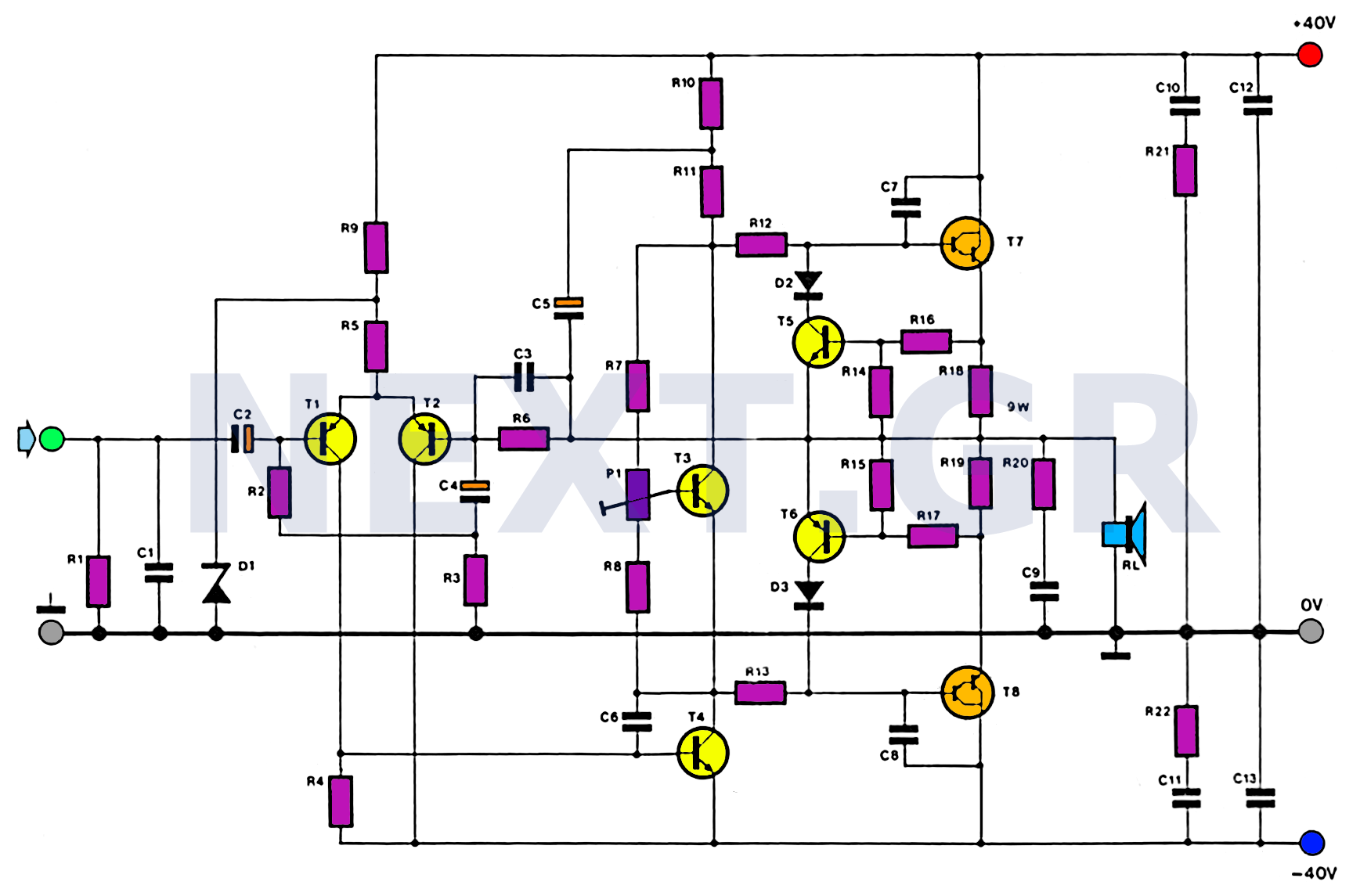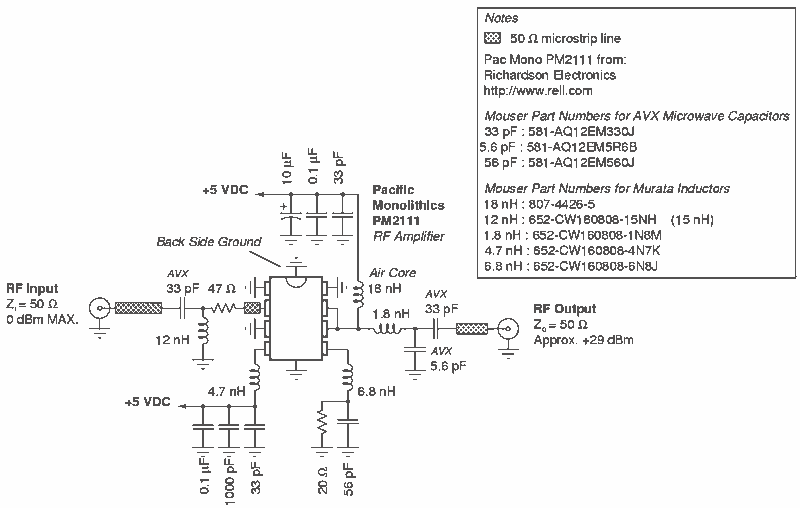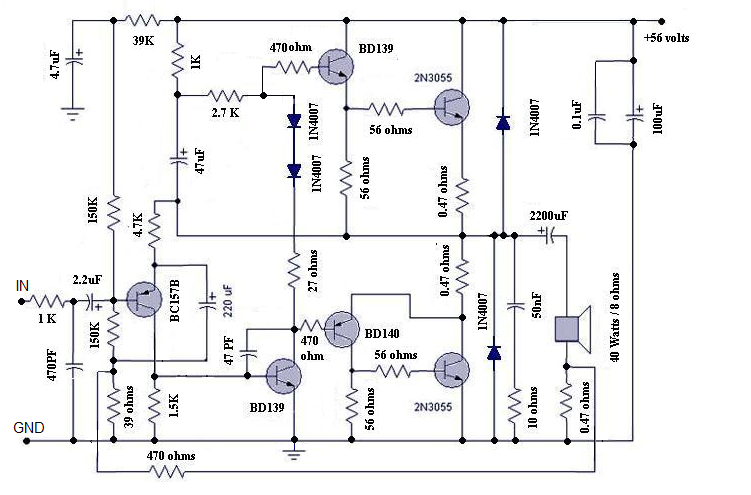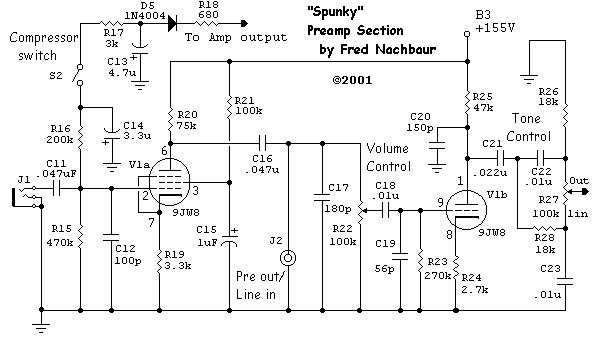
50W class AB amplifier
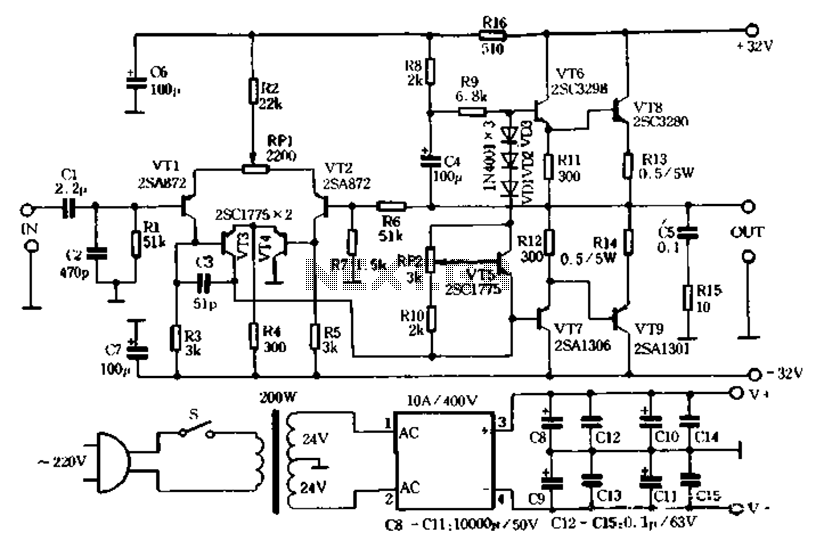
Fans are eager to create a high-quality amplifier; however, many of the most notable publications on the circuit tend to be overly complex and difficult to implement. This article describes a pure Class AB output stage amplifier circuit that is simple and offers satisfactory sound quality. Interested individuals may wish to experiment with the core of the circuit illustrated in Figure 4-3. Components VTI and VT4 form a differential amplifier, while VT6 and VT7 serve as the power output transistors. VT8 and VT9, along with diodes VD1, VD3, and VD5, provide biasing for VT6 to VT9. The circuit's gain is controlled by resistors R6 and R7, achieving a gain of approximately 30 times. The overall design of the circuit is straightforward and easy to understand. Adjusting the circuit is quite simple: set the midpoint potential using adjustment potentiometer RP1 to 0V; then adjust RP2 to ensure that the voltage across resistor R13 is approximately 0.1V. Repeated adjustments may be necessary before the circuit can be put into operation.
The described pure Class AB output stage amplifier circuit is designed to provide a balance between performance and simplicity, making it an attractive option for enthusiasts and professionals alike. The differential amplifier formed by transistors VTI and VT4 allows for effective signal amplification while minimizing distortion. The choice of components, particularly the power output transistors VT6 and VT7, is crucial for achieving the desired output characteristics, including linearity and thermal stability.
To further elaborate on the circuit's operation, the biasing network involving diodes VD1, VD3, and VD5 plays a vital role in ensuring that the output transistors operate in their optimal range, thus enhancing the overall fidelity of the amplifier. The resistors R6 and R7 not only control the gain but also help in setting the input impedance of the amplifier, which is essential for matching with various audio sources.
The adjustment process outlined is critical for fine-tuning the amplifier's performance. Setting the midpoint potential to 0V with RP1 ensures that the amplifier operates in a balanced state, preventing crossover distortion. The adjustment of RP2 to achieve a voltage of approximately 0.1V across R13 is indicative of the quiescent current flowing through the output stage, which is key to maintaining the Class AB operation without significant thermal runaway.
Overall, this amplifier circuit represents a practical solution for those looking to build a high-quality audio amplifier without delving into overly complicated designs. The straightforward nature of the circuit, combined with the clear adjustment procedures, makes it accessible for both novice and experienced builders.Fans are hoping to make a high-quality amplifier, but the most outstanding publications published on the circuit, they often too complex and difficult to start 6 This article d escribes a pure class AB output stage amplifier circuit, the circuit is simple, sound quality is satisfactory, Hing interested persons may wish to try the heart of the circuit shown in Figure 4-3. VTI ~ VT4 composed of one, two differential amplifier, VT6 ~ VT7 constitute power output tube, VT8VT9 to promote o VDl --VD3VT5 circuit providing a bias to VT6 ~ VT9.
Gain of the circuit by the R6, R7 control about 30 times. The entire circuit is simple and clear, at a glance. Adjustment of the machine is very simple: to make the midpoint potential of adjustments RP1 ov; adjust RP2, so that the voltage across R13 is about 0.1V. Several times repeated adjustments can be put into use
The described pure Class AB output stage amplifier circuit is designed to provide a balance between performance and simplicity, making it an attractive option for enthusiasts and professionals alike. The differential amplifier formed by transistors VTI and VT4 allows for effective signal amplification while minimizing distortion. The choice of components, particularly the power output transistors VT6 and VT7, is crucial for achieving the desired output characteristics, including linearity and thermal stability.
To further elaborate on the circuit's operation, the biasing network involving diodes VD1, VD3, and VD5 plays a vital role in ensuring that the output transistors operate in their optimal range, thus enhancing the overall fidelity of the amplifier. The resistors R6 and R7 not only control the gain but also help in setting the input impedance of the amplifier, which is essential for matching with various audio sources.
The adjustment process outlined is critical for fine-tuning the amplifier's performance. Setting the midpoint potential to 0V with RP1 ensures that the amplifier operates in a balanced state, preventing crossover distortion. The adjustment of RP2 to achieve a voltage of approximately 0.1V across R13 is indicative of the quiescent current flowing through the output stage, which is key to maintaining the Class AB operation without significant thermal runaway.
Overall, this amplifier circuit represents a practical solution for those looking to build a high-quality audio amplifier without delving into overly complicated designs. The straightforward nature of the circuit, combined with the clear adjustment procedures, makes it accessible for both novice and experienced builders.Fans are hoping to make a high-quality amplifier, but the most outstanding publications published on the circuit, they often too complex and difficult to start 6 This article d escribes a pure class AB output stage amplifier circuit, the circuit is simple, sound quality is satisfactory, Hing interested persons may wish to try the heart of the circuit shown in Figure 4-3. VTI ~ VT4 composed of one, two differential amplifier, VT6 ~ VT7 constitute power output tube, VT8VT9 to promote o VDl --VD3VT5 circuit providing a bias to VT6 ~ VT9.
Gain of the circuit by the R6, R7 control about 30 times. The entire circuit is simple and clear, at a glance. Adjustment of the machine is very simple: to make the midpoint potential of adjustments RP1 ov; adjust RP2, so that the voltage across R13 is about 0.1V. Several times repeated adjustments can be put into use
